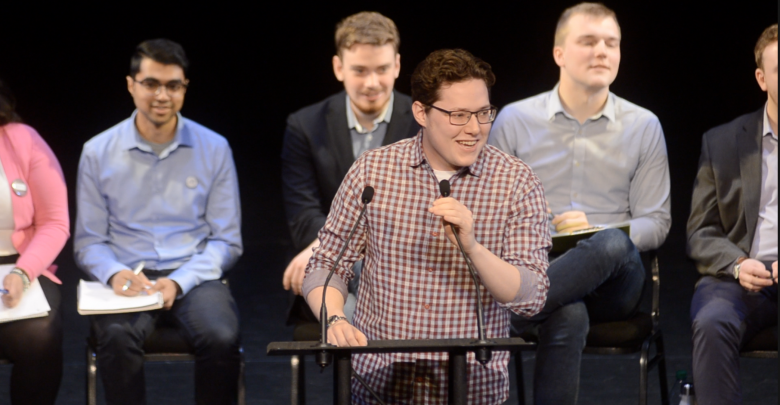 Oumar Salifou
Oumar SalifouEach year, The Gateway publishes an evaluation of the Students’ Union Executive and the Board of Governors representative. It’s impossible to discuss every aspect of their tenures, so these reports are largely based on the major components of the platform each executive campaigned on, and the most significant responsibilities of their respective positions. These evaluations were informed by interviews with the executives themselves. The grading rubric can be found below. And if you’re short for time, check out our TLDR for a bite-sized breakdown.
Luke Statt: C
When it comes to the Students’ Union, the goal of the vice-president (operations and finance) is to curate the SU’s $11 million budget each year, in addition to looking after the SU businesses on campus (SUB businesses, RATT, Dewey’s, etc.) and sitting on committees related to Dedicated Fee Units (DFUs). Luke Statt has, on the surface, done his job well — but is this still the case if we dive deeper?
Statt has been gushing about this year’s Dewey’s renovation since it was done this summer; however, it wasn’t exactly groundbreaking. The bar was removed from the backroom, some furniture was shuffled around, they put mirrors in the bathrooms. The standards for this renovation were low, but Statt is “quite happy with everything.” He considers the branding and menu changes to be a huge success, but, if he started the project over, would like to renovate the second loft as well. These minimal changes, alongside technical improvements like a better sound system, make for an overwhelmingly average renovation. Though the space is more open for student groups and events now, which was a supposed goal, there are currently no upcoming events on Dewey’s Facebook page.
The vice-president (operations and finance) race was uncontested last year, meaning that Statt had to do only the bare minimum on the campaign trail to be elected. However, instead of taking advantage of this and only promising things he could make happen within his term, he chose to speak about outrageous goals that could never be accomplished in just one year.
For instance, he spoke at length during the campaign about his desire for the SU to become entirely self-sufficient, but he now thinks that it will take more than a decade for this to become a reality. Statt cited his expansion of SUTV — a digital signage platform and an advertising medium for the SU — as evidence of his commitment to this goal, but then looped back again to renovations as a way of drawing more students into SU businesses. It’s not so hard to come to the realization that, in this model of forward movement, the onus is put on students to be good customers, rather than ads and businesses to run smoothly.
In terms of student space improvement, Dewey’s is nearly the only place Statt can honestly showcase. His plans for Campus Saint-Jean were derailed, and though there is now a new, “better” tenant catering there, no work was done to improve the space itself. Of course, we didn’t see improvements in HUB, CCIS, or SUB either. And although he mentioned his satisfaction with the CAB renovations, this was — again — not his project. When asked what some of the most significant changes he made this year were, his first answer was replacing Konz with BarBurrito, which was only a “half-joke.”
ARRC has seemingly fallen by the wayside this year too. Statt says that they’ve “indicated to [him] that they’ve felt fairly well supported,” but also that he underestimated the amount of money it would take to complete the Indigenous mural in HUB. A quick Google search indicates that the average cost of a mural is anywhere from $10-20 per square foot, and Statt only set aside $1500 for a 325 square foot space. This is without even considering the level of specialty and care required to compose a mural created by specialized Indigenous artists for the purpose of reconciliation. This oversight doesn’t feel intentional, but it does feel lazy, and ARRC doesn’t deserve that.
Though Statt can boast a new tiered plan option for the health and dental plan, an improved UASU Perks website, and a targeted bursary plan for the next five years, these accomplishments are not immediately visible to students. Statt blames the public nature of the role and unannounced ventures for the lack of depth in his actions this year, but how deep do we have to dig to find substance?
TLDR: Statt, though capable in his role this year, overpromised in his campaign, and was unable to follow through on several items. Certain things, like the health and dental plan, were for the good of the students, but were overcast by his heavy emphasis on the lacklustre Dewey’s renovation. His overall term has been mediocre, and his continuing initiatives reflect that.
Rubric:
A-range: This person has fulfilled the promises they campaigned on and more, and has created tangible change during their tenure, and has shown a commitment to improving the lives of students. Their GPA is off the charts.
B-range: This person has done their job consistently well, but has not made any remarkable changes, or has fallen short on important goals they set out in their platforms. They’re doing fine, but it’s nothing to phone home about.
C-range: This person has done their job sufficiently, but has failed to make significant progress in the areas most relevant to their portfolio, or has essentially abandoned a major part of their platform. They’re still passing with a safe buffer though, and Cs get degrees!
D-range: This person has done a very lacklustre job, and has not sufficiently fulfilled their campaign promises or the responsibilities of their position.
F-range: This person has not done their job, has not represented students, and has not fulfilled their campaign promises whatsoever.




